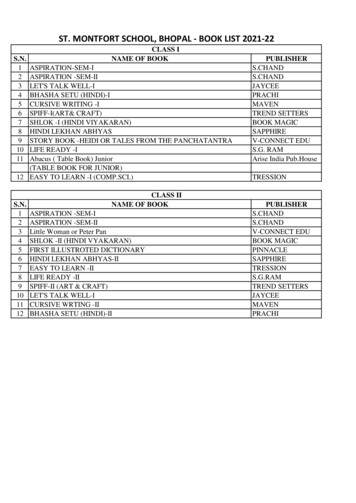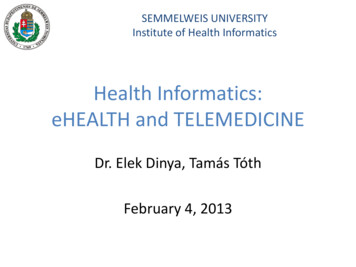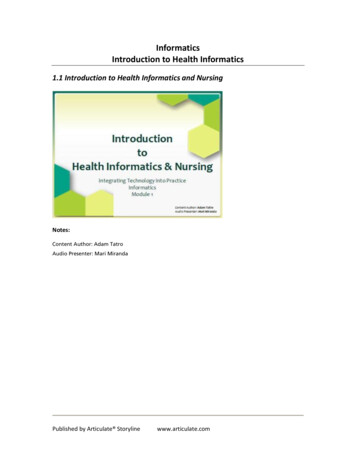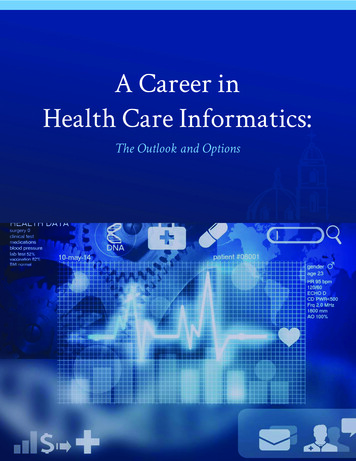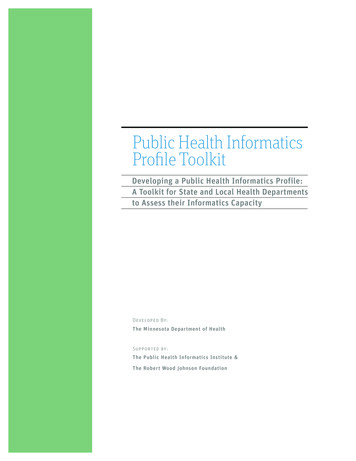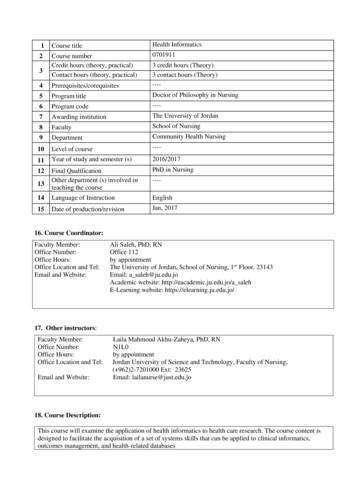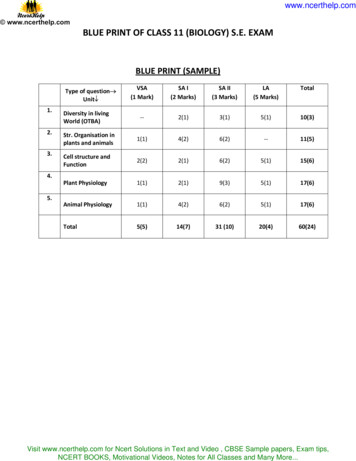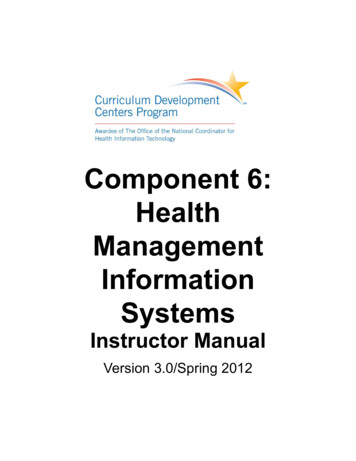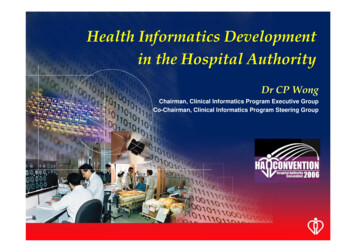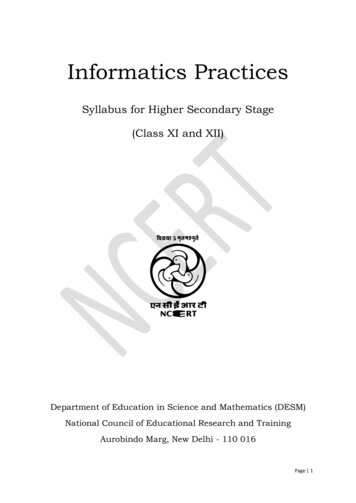
Transcription
Informatics PracticesSyllabus for Higher Secondary Stage(Class XI and XII)Department of Education in Science and Mathematics (DESM)National Council of Educational Research and TrainingAurobindo Marg, New Delhi - 110 016Page 1
Syllabus of Informatics PracticesHigher Secondary Stage (Class XI and XII)Rationale:In the present education system of our country, specialised, discipline basedcourses are introduced at the higher secondary stage. This stage is crucial and aswell as challenging because of the transition from general to discipline-basedcurriculum and the pressure to perform better to get admission to desired highercourse. National Curriculum Framework (NCF) 2005 recommends syllabus at thisstage to have sufficient rigour and depth while being appropriate to thecomprehension level of learners and at the same time not to be heavily loaded withcontents.Informatics Practices (IP) is offered as an elective subject at the highersecondary stage of school education. At this stage, students take up IP with theaim of pursuing their interest and further study in computer applicationdevelopment and data science at higher levels. Courses offered till the mationTechnology(IT)/Information and Communication Technology (ICT) by various boards andschools up to secondary stage are also optional and largely focus on teaching officeautomation tools and other application software. Therefore, at higher secondarystage, for learners without background knowledge of computer science, there is aneed to introduce the basics of Computer as well as the importance of data sciencein today’s scenario. Covering up the sufficient conceptual background ofInformatics is required to make learners competent to meet the challenges ofacademic and professional courses after the higher secondary stage.Informatics is concerned with the study of Information Systems designed forcreating, recording, storing, processing and communicating information. Byutilizing the power of Information Technology, we can extract knowledge from dataand information, which is otherwise difficult to visualise. In a data driven world,Informatics plays key role in the way we live, work and think. The syllabus ofInformatics Practices attempts to start with “how do computers work” and traversethrough the fundamentals of programming and then focus mainly on the role ofdata and the importance of handling and interpreting meaning out of data.Emphasis is given to the representation of data, their processing, searchingthrough queries and visualization. The syllabus has been developed based on thefollowing broad areas which have been further classified into chapters:Page 2
Fundamentals of computers: Brief introduction to a computer system includingfunctional components, memory, role and type of software. The idea is to createawareness about the emerging trends in IT and IT enabled applications andservices.Programming: The basic constructs of a structured programming approach thatincludes program structure, identifiers, variables, control structure. Python datastructures lists, dictionaries and their handling are discussed. The aim is toempower learners to be confident of writing programs and small applicationprojects.Database Management: An introduction to Data, Database and its purpose,trends of data driven decision making in key areas are highlighted. The collectionand storage of data in a file system as well as database system are compared.Introduction to relational data model, RDBMS, and programming using StructuredQuery Language (SQL) are covered to enable learners to create, manipulate andquery a database.Data Handling: The Python library for numeric data handling and analysis calledNumpy is introduced. Analyzing data through basic statistics and its interpretationare covered briefly. Two other Python libraries called Pandas and Matplotlib areused to introduce methods of data processing and visualization.Internet and Web: An introduction to Internet, World Wide Web and its structureare covered to give an overview about the ICT. Brief overview of web browser,websites, webpages, as well as web server and web publishing are included.Societal Impact of IT: The societal challenges that are arising along with theexpansion in usage of technology are highlighted here. How to be safe and securewhile browsing and communicating online as well as the importance of social,ethical values, and soft skills are highlighted. The rising issues such as of cyberbullying, cyber crime and hacking are discussed to empower the learner tosafeguard themselves and their peers. Issues like copyright, plagiarism, IPR, alongwith their ethical and legal aspects are explained. Environmental and healthconcerns of usage of digital devices are included to enable learners to makeinformed decisions while using technology.Page 3
After the completion of the two years course student will be able to: identify the functional components of a computer system; identify the emerging trends in the field of computer and informationtechnology and elaborate how they influence modern society; distinguish between proprietary and open source software; understand the importance of data in discovering interesting knowledge; recognise the importance of storing data for subsequent use; understand concepts of data management and relational DBMS and itsneed; create a relational database using MySQL use SQL to search data from a database in different manners; aggregate, analyze data using Python Data vectors and Frames; visualizing and plotting of data for better understanding of data and plotdata; develop some idea about how the Internet and Web works; recognize the impact of Information Technology on Society and theprecautions to be taken in a digital world.Page 4
Course Outline for Class XITotal Periods 180 (including practical periods)Chapter 1: Computer System10 PeriodsIntroduction to computer and computing: evolution of computing devices, functional components ofa computer system and their interconnections, I/O devices.Computer Memory: Units of memory, types of memory – primary and secondary; data deletion, itsrecovery and related security concerns.Software: purpose and types – system and application software, generic and specific purposesoftware.Chapter 2: Emerging TrendsBrief understanding of the following emerging trends:10 PeriodsArtificial Intelligence, Machine learning, Natural Language Processing, Immersive experience (AR, VR),Robotics, Big data and its characteristics, Internet of Things (IoT), Sensors, Smart cities, CloudComputing and Cloud Services (SaaS, IaaS, PaaS); Grid Computing, Blockchain technology.Chapter 3: Brief overview of Python35 PeriodsBasics of Python programming, Python interpreter - interactive and script mode, structure of aprogram, indentation, identifiers, keywords, constants, variables, types of operators, precedence ofoperators, data types, mutable and immutable data types, statements, expressions, evaluation andcomments, input and output statements, data type conversion, debuggingControl Statements: if-else, for loopChapter 4: Working with Lists and Dictionaries25 PeriodsLists: list operations - creating, initializing, traversing and manipulating lists, list methods and built-infunctionsDictionary: concept of key-value pair, creating, initializing, traversing, updating and deleting elements;dictionary methods and built-in functions.Chapter 5: Understanding Data5 PeriodsData and its purpose, importance of data, types of data - structured, unstructured, structured datatypes - quantitative and qualitative data, data processing cycle, Basic statistical methods forunderstanding data - Mean, Median, Mode, Standard Deviation and VariancePage 5
Chapter 6: Data Handling using NumPyArray - 1D, 2D arrays40 PeriodsIntroduction to NumPy library, NumPy arrays and their advantage, Creation of NumPy Arrays, Loadingtext files into Arrays; Indexing, Slicing, and Iteration; Concatenating and Splitting Array; Arithmeticoperations on 1D, 2D arrays,Calculating max, min, count, sum, mean, median, mode, standard deviation, variance on NumPy arraysChapter 7: Database Concepts15 PeriodsDatabase Concepts: Introduction to database concepts and its need.Relational data model: Concept of domain, tuple, relation, candidate key, primary key, alternate key,foreign key;Chapter 8: Structured Query Language40 PeriodsAdvantages of using Structured Query Language, Introduction to MySQL, Creating a database usingMySQL, Data TypesData Definition: CREATE TABLE, DROP TABLE, ALTER TABLE,Data Query: SELECT, FROM, WHEREData Manipulation: INSERT, UPDATE, DELETEPage 6
Course Outline for Class XIITotal Periods 180 (including practical periods)Chapter 1: Database Query using SQLMath functions: POWER (), ROUND (), MOD ().50 PeriodsText functions: UCASE ()/UPPER (), LCASE ()/LOWER (), MID ()/SUBSTRING ()/SUBSTR (),LENGTH (), LEFT (), RIGHT (), INSTR (), LTRIM (), RTRIM (), TRIM ().Date Functions: NOW (), DATE (), MONTH (), MONTHNAME (), YEAR (), DAY (), DAYNAME ().Aggregate Functions: MAX (), MIN (), AVG (), SUM (), COUNT (); using COUNT (*).Querying and manipulating data using Group by, Having, Order by.Operations on Relations - Union, Intersection, Minus, Cartesian Product, JOINChapter 2: Data Handling using Pandas – I35 PeriodsIntroduction to Python libraries- Pandas, NumPy, Matplotlib.Data structures in Pandas - Series and DataFrames.Series: Creation of Series from – ndarray, dictionary, scalar value; mathematical operations; Head andTail functions; Selection, Indexing and Slicing.DataFrames: creation - from dictionary of Series, list of dictionaries, Text/CSV files; display; iteration;Operations on Rows and columns: add, select, delete, rename; Head and Tail functions; Indexing usingLabels, Boolean Indexing; Styling & Formatting data, Head and Tail functions; Joining, Merging andConcatenations.Importing/Exporting Data between CSV files and DataFrames.Chapter 3: Data Handling using Pandas – II35 PeriodsDescriptive Statistics: max, min, count, sum, mean, median, mode, quartile, Standard deviation,variance.DataFrame operations: Aggregation, group by, Sorting, Deleting and Renaming Index, Pivoting.Handling missing values – dropping and filling.Importing/Exporting Data between MySQL database and Pandas.Chapter 4: Plotting Data using Matplotlib25 PeriodsPurpose of plotting; drawing and saving following types of plots using Matplotlib – line plot, bargraph, histogram, pie chart, frequency polygon, box plot and scatter plot.Customizing plots: color, style (dashed, dotted), width; adding label, title, and legend in plots.Page 7
Chapter 5: Introduction to Computer Networks15 PeriodsIntroduction to networks, Types of network: LAN, MAN, WAN.Network Devices: modem, hub, switch, repeater, router, gatewayNetwork Topologies: Star, Bus, Tree, Mesh.Introduction to Internet, URL, WWW and its applications- Web, email, Chat, VoIP.Website: Introduction, difference between a website and webpage, static vs dynamic web page, webserver and hosting of a website.Web Browsers: Introduction, commonly used browsers, browser settings, add-ons and plug-ins,cookies.Chapter 6: Societal Impacts10 PeriodsDigital footprint, Etiquettes for Net surfing and for communicating through social medias, dataprotection, Intellectual Property Rights (IPR) and their violation, plagiarism licensing and copyrights,Free and Open Source Software (FOSS), Cyber crime and cyber laws, hacking, phishing, cyber bullying,Overview of Indian IT Act, preventing cyber crime.E-waste its hazard and managementAwareness about health concerns related to usage of technology like effect on eyesight, physiologicalissues and ergonomic aspects.Project Work10 PeriodsThe aim of the class project is to create tangible and useful IT application. The learner may identify areal-world problem by exploring the environment. e.g. Students can visit shops/business places,communities or other organizations in their localities and enquire about functioning of theorganization, and how data are generated, stored and managed.The learner can take data stored in csv or database file and analyze using Python libraries andgenerate appropriate charts to visualize.If an organization is maintaining data offline, then the learner should create a database using MySQLand store the data in tables. Data can be imported in Pandas for analysis and visualization.Learners can use Python libraries of their choice to develop software for their school or any othersocial good.Learners should be sensitized to avoid plagiarism and violation of copyright issues while working onprojects. Teachers should take necessary measures for this. Any resources (data, image etc.) used inthe project must be suitably referenced.The project can be done individually or in groups of 2 to 3 students. The project should be started bystudents at least 6 months before the submission deadline.Page 8
Internet and Web: An introduction to Internet, World Wide Web and its structure are covered to give an overview about the ICT. Brief overview of web browser, websites, webpages, as well as web server and web publishing are included. Societal Impact of IT: The societal challenges that are arising along with the
